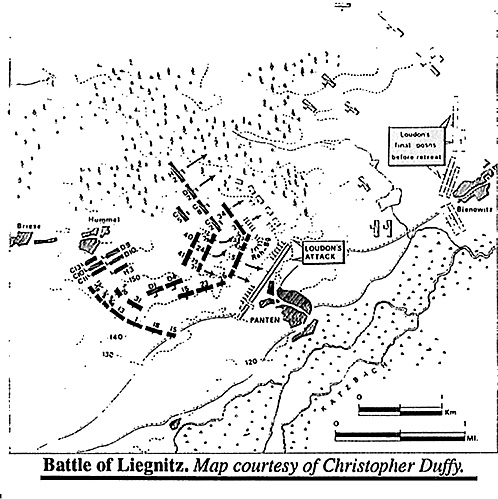To my misfortune, I was ill this day and did not travel to Liegnitz. I was told that I hadn't missed much. Perhaps our editor would fill in the details for this account.
Editor's Comments on Liegnitz:
The battle of Leignitz was fought on August 15, 1760 between Frederick (30,000 men) and Loudon's corps (24,000 men)of a larger Austrian army (another 66,000) commanded by Daun. The 1760 campaign had opened with Frederick operating in the Saxon theater against Daun and Prince Henry protecting Silisia from the Austrian forces commanded by Loudon, as well as the Russian army of Saltykov and others. Loudon's capture of Landeshut and Glatz compelled Frederick to turn his attention to Silesia. By August, Frederick was positioned along the Katzbach River, 40 miles north of Breslau, and found himself the target of converging forces of Daun, Loudon and 25,000 Russians commanded by Chernyshev.
Battle of Liegnitz. Map courtesy of Christopher Duffy.
The Austrians resolved to bring the Prussians to battle in a plan similar to the one employed with such success at Hochkirch in 1758.
Daun would strike the main blow from the southwest while Loudon would cross the Katzbach in the Prussian rear and block any escape from Daun's attack. The objective was the complete destruction of Frederick's army.
By chance, Frederick moved his army beyond Daun's reach (better to be lucky than right) on the night of August 14th and learned about the pending Austrian attack from a deserter. He left part of his army facing Dann and shifted the majority of his army to a small rise known as the Reh Berg, which overlooked the Katzbach and awaited Loudon's attack. Loudon commenced his attack at dawn, and expecting to strike the Prussian rear, was utterly caught off guard when he found himself eyeball to eyeball with Alte Fritz and his 12 pounders.
Austrian grenadiers spearheading the attack were thrown back by the Prussian cannon and muskets. Two more attacks also failed.
Frederick now ordered a counter-attack with his left wing. The attack was enthusiastically led by the recently disgraced Alt Bernberg Regiment (IR 3), which was eager to win back the good favor of the king. The Prussian attack drove Loudon off the Reh Berge. The Austrians executed an orderly retreat through the towns of Panten and Bienowitz. Every so often, Austrian battalions would turn around and fire at their overzealous pursuers.
The whole action took no more than two hours, leaving Daun little time to find his way through the dark and join the early morning battle which was over by 6:00 A.M.
The Duffy Tour motored its way north from Breslau, passing through the Leuthen field once again, and finally crossing the Katzbach in a short amount of time. The Katzbach is a small stream, but it is characterized by its swift current and very steep banks. Accordingly, it is impossible for artillery to cross the stream, except by bridge and cavalry units would probably experience similar difficulties in making the crossing. Duffy pointed out that the Katzbach seemed to dominate campaigning in this part of Silesia. The army that held the Katzbach line could keep the other side penned in to northern Silesia (if the Austrians were there first) or southern Silesia (if the Prussians were there first). In point of fact, Prince Charles was trying to advance his army to the strategic Katzbach position prior to the battle of Leuthen, and he fell back towards Breslau when he learned that Frederick had gotten there first.
Our bus followed the route of Loudon's advance from Bienowitz to Panten. We disembarked at Panten and observed the remains of what had once been a massive Soviet military base at Liegnitz. It was now rusting and decaying and was absent of any military personel. We made the short hike up the Reh Berge, passing through a wooded area that likely did not exist in 1760. The woods gave way to an open field rising towards the Reh Berge. One could see that while the hill was not very high, it held a commanding view of the Katzbach crossing. In fact, it was the only high ground in the vicinity. The open crest was, as Duffy put it, 'stuffed full of Prussian troops waiting for Loudon's attack'.
After the battlefield tour, Todd Fisher directed us through a tour of the Napoleonic battle of the Katzbach. Since I know very little about this episode and since it has nothing to do with the SYW, I will not recount that part of the tour. My single impression of the Napoleonic battlefield was that it seemed ten times larger than any SYW battlefield that I had ever seen.

More 1998 Frederick the Great Tour
-
Frederick the Great Tour: Introduction
Frederick the Great Tour: May 16: Kunersdorf
Frederick the Great Tour: May 17: Leuthen
Frederick the Great Tour: May 18: Landeshut and Mollwitz
Frederick the Great Tour: May 19: Bunzelwitz and Hohenfriedberg
Frederick the Great Tour: May 20: Liegnitz
Frederick the Great Tour: May 21: Glatz (Klodzo)
Frederick the Great Tour: May 22: Burkersdorf and Reichenbach
Frederick the Great Tour: May 23: Zorndorf
Frederick the Great Tour: May 23: Last Night in Berlin
Back to Seven Years War Asso. Journal Vol. X No. 3 Table of Contents
Back to Seven Years War Asso. Journal List of Issues
Back to Master Magazine List
© Copyright 1998 by James E. Purky
This article appears in MagWeb (Magazine Web) on the Internet World Wide Web.
Other military history articles and gaming articles are available at http://www.magweb.com